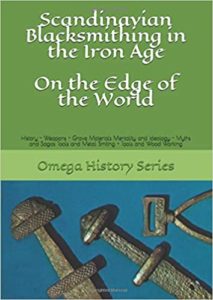Scandinavian Blacksmithing in the Iron Age: On the Edge of the World
By: Sverre Chistoffer Guldberg

Price : Free – University of Oslo
Philip’s Ranking: 1
Beginner Blacksmith: 0
Advanced Blacksmith: 0
Inspiration: 0
Historical: 2
Video Review: N/A
***Important Note*** – The author of this paper contacted me and let me know that the Omega History Series has published his archaeology master’s thesis without his consent and has stolen his work. If you would like to read this work it is freely available from his Open Access work from the University of Oslo website: https://www.duo.uio.no/handle/
This book is focused on how archeologists looking at Iron Age Scandinavian graves have interpreted those graves and makes the argument that “smithing” tools found in the graves should be seen as both mystical and status symbols. The author also argues that many tools identified as “smithing” tools could have a variety of uses and attributing them only to ironwork is probably resulting in graves being misidentified as blacksmith graves.
I am not at all an expert or even novice in this area but I think the author makes a compelling argument that the mystical and status symbiology associated with crafting tools of all kinds, and especially blacksmithing tools, means that individuals who wanted to be associated with those symbols would have good reason to have them buried as grave goods even if the individual was not a smith.
I found the most interesting part of the book to be the authors review of the types of tools (axes/adzes, anvils, tongs, nail irons, gouges, augers, saws, awls, hammers, chisels, and punches) found in the graves to be interesting. The author then attempts to identify which of these tools would be specifically for blacksmithing, metalworking, wood working, soft-material smithing vs. tools that could be used across multiple crafts and comes to the conclusion that it is really hard to know if a something like a chisel is for blacksmithing, silversmithing, woodworking, stonework, or some other craft. Because of this inability to definitively identify what craft a tool was used in a grave with a chisel shouldn’t be automatically classified as a blacksmiths grave.
Unless you are specifically interested in how Scandinavian archology is interpreting grave finds I wouldn’t recommend this book.